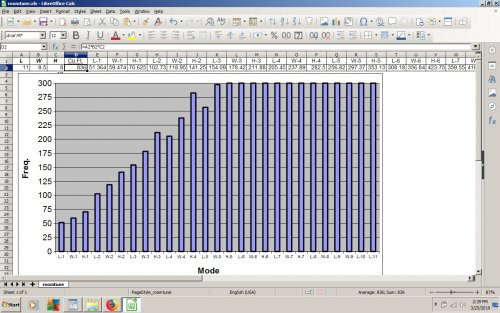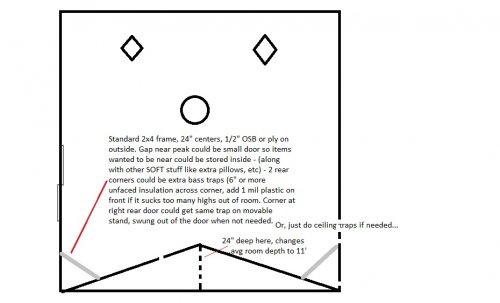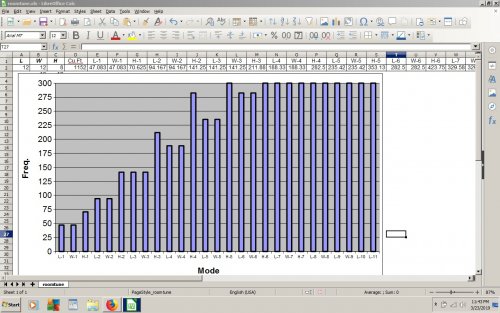-
Posts
15 -
Joined
-
Last visited
Reputation
4 Neutral-
Have you tried doing it this way? https://www.cakewalk.com/Support/Knowledge-Base/2007013079/Converting-or-Recording-MIDI-to-Audio Steve
-

Presonus Faderport 16 - anyone using it in CbB?
Steve Leverich replied to Bapu's topic in Cakewalk by BandLab
Mark - "Look in C:\Program Files\Cakewalk\Shared Surfaces" - I'm guessing that would require having the program already installed; I'm still purging/delousing Win10 on the new machine, and lining up as many "ducks" as I'm aware of, thanks for the tip - Bob, thanks - My newest paid for version of Vegas is V9.0 Vegas Pro suite. It's been awhile since I dealt with Magix, don't really wanna go there yet. That part of the new setup is purely personal use, V9 was already more than I needed. It paid for itself about 40 times over just from revenue from several corporate safety vids, had the CEO himself tell me mine were the best he'd ever seen... The new machine is getting a TI firewire card (already installed along with ram kicked up to 32 Gb, and a Motu 24Ai/ 8Pre-ES along with my older MTP-AV usb. I'm a bit nervous about the Motu stuff playing nice with the above, but I really wanted all those inputs so I can keep using several keyboards AND quite a few sound modules. Between the 8Pre-ES, my ART Digital MPA and Focusrite Platinum Voicemaster Pro, those will give me 24 balanced line ins and 11 mic pre's; prior to this I've always had to do a submix on the board in order to mic drums in real time, so I'm looking forward to that capability... Steve -

Presonus Faderport 16 - anyone using it in CbB?
Steve Leverich replied to Bapu's topic in Cakewalk by BandLab
Yeah, as long as that path doesn't end at the litter box :=) OK, so it's now obvious that CbB (or at least Sonar) DOES work with Mackie control - however the recently released CbB "manual" has ZERO mention of this - if you do a search on "Mackie" all you get is a few things about Otto. I'm considering the Presonus FaderPort 16 also, new DAW will get some of my older (Sonar X1, Vegas Pro 9, Sound Forge 11) software as well as CbB. Not sure yet if Vegas will work with either HUI or Mackie Control, more research to do... Guess I shoulda put part of this with the thread on the CbB manual - so I will... Steve -
"Clutter- the secret weapon" - Tell your clients it's "Large Scale Diffusion" - you'd explain the complex math behind it, but it's a trade secret :=)) ...Steve
-
funny you should mention that - I was gonna suggest (til I got sidetracked) making some curtains for that sliding door from old sleeping bags, covered with cloth of choice - that alone is about 36 sq ft of "mirror" that's gotta go, plus it's smack in the middle of a first reflection point... Steve
-
Greg, I agree with Tezza too, many variables to consider here - keep in mind though, unless the proposed shelf unit has a SOLID front (as in, enclosed by doors) it will NOT make a noticeable change in room modes, which are definitely NOT helping any boominess - maybe if you have a bunch of "bric-a-brac" items on those shelves it would add some diffusion, but that's (arguably) not much help in small rooms (less than about 20' paths) Anyway, best of luck on a quick sale of your old house, hopefully that'll let you fill some of the gaps in your kit - besides the acoustic help, I'd probably be looking at either bigger speakers, a sub, or both - the sound level meter is a MUST for me; the human ear has no vu meter, it adapts to however loud things are, then accepts that as "normal", so it's real easy to screw up your hearing unless you let something that IS measurable help you. I keep mine on the mix desk set on "C" weighting, and when peaks vary away from 85 dB I change the main volume to compensate - this, along with a good balance between mains and sub, and mixes are a lot more uniform and "transportable"... Steve
-
Yeah, you got busted just like everyone else does - I initiated that policy just over 16 years ago, and STILL almost nobody reads it til they're yelled at :=) - Stuart likes to do things right, and while I agree with that philosophy I will sometimes "cheat" rather than either do nothing, or wait longer than my patience thinks I should. The first thing I would probably do in your budgetary situation: if you have an android phone, google play store has some interesting free apps - check out these two - sound analyzer free by nobapp, pink noise player by dogfooder You would actually need TWO phones (borrow your wife's), play the pink noise thru headphone jack into your monitors, use the analyzer on other phone (put it somewhere near the center of room, DO NOT CHANGE ITS POSITION OR SETTINGS OR ANYTHING til subsequent tests are done - (other than the INTENDED ONES, duh) Caveat - this is NOT in ANY way a precision test; using this approach can ONLY be used to see CHANGES in a room, and ONLY if absolutely NOTHING ELSE is changed/moved between tests; I'm reminded of one of my favorite cartoons showing two buzzards sitting on the arms of a saguaro cactus; one looks at the other and says, "Patience my ASS, I'm gonna KILL somethin'..." Don't wanna get your hopes up, but I have the exact sound level meter Stuart recommends AND an acoustic measurement mic (VERY small condenser, omnidirectional, flat from 20-20k - unfortunately I have NO IDEA where they're at right now, or I'd be tempted to put 'em in a medium flat rate box and loan 'em to you for a few months... The lack of location problem is due to me trying to clean out both spare bedrooms, moving everything OUT of one INTO the other, when BOTH were already "full" - goal is to turn ONE br into an interim "sanity saver" while I try to figure out how to enlarge my old "practice room" from 12'x36' to a multi-room 24'x48' ACTUALLY SOUNDPROOF space - this will be a multi-year endeavor, so having a "sanity sanctuary", even a small one, is vital to the health of me and my entire extended family :=) Back to the immediate problem; doing what I sketched would definitely CHANGE your room, but it sounds like even a few hundred$$ isn't a good plan at this time - I'll post it anyway, if only for discussion. Change just ONE of the dim's to 11' (the AVERAGE, if the trap is 2' deep at peak) and see what the modes do... I did apparently "luck out" more than you on my "sanity saver" room; just measured it, dim's are 9.5'x11'x8' ceiling - I'll post its axial mode too, notice the smooth even changes in mode frequencies? this is what I talked about earlier, compare it to YOUR room's modes and you'll see why there've been several comments on room shape. Oh, added bonus - that room has a 4.5' x 2' deep closet, CENTERED in the back wall - 4" of rockwool semi-rigid across that and might not need any OTHER bass traps... Gotta go do a couple things before SWMBO decides I'm goofin' off too much... Steve
-
Seriously, take the time to join John's forum; this one link http://johnlsayers.com/phpBB2/viewtopic.php?f=3&t=7814 will MORE than be worth the time it takes to join, it's a picture-heavy account of one member's absorber builds - you won't see any pics if you're not logged in. I'm working on a rough paint sketch of your room that would tame some of your modes, give some bass trapping, cost a few hundred$$$, and be completely removable/recyclable if you change your mind - later... Steve
-
I can't argue with the requests to post a recording, it never hurts to have a second (or 15th) set of ears; thing is, the recording you've been listening to sound "fine" on your cans, so that can't be the one you post - you'll need to set up Sonar to record a mic (at the mix position) while playing back your recording on your speakers - the mic you record with should be preferably a small diaphragm condenser, omni pattern if you have one, with levels set hot but NOT clipped . (That type mic is generally flatter response, altho I have a couple small condensers that're hypercardiod, and they do fine if you're careful aiming 'em :=) Also, make sure you record DRY - no FX whatsoever. Then you'd need to post BOTH files, labeled so we know which is which - make sure that ONLY your pre-recording is in the monitors at the time... Then, after seeing what's what in your room I would try playing back your original recording again; first, with all doors/windows closed, then open them all (even the closet ones) and listen again, as soon as possible after first listen - then, if your sliding door has curtains CLOSE them (and the door) for a third test. Since you'd already be set up to record the speaker output, it'd be good if you could ALSO record each test, making sure NOT to disturb the mic AT ALL for ALL these tests - I know it's a PITA, but you'll find that ol' "good-fast-cheap" triangle is a bitch to avoid (seems like MOST of the time, even getting to pick TWO is unlikely...) Oh, forgot - yes, your foam wedge stuff will change 'verb some, 'cause it starts working a bit somewhere in the 4-5 kHz and up range - 'way back when the earth was flat and I was still playing in bands, I had tried the ol' egg crate trick (who hasnt?) on the 8'x12' section of wall behind our drummer (one of the few that can sing better than most lead singers "=) - I first stapled leftover "regurgitated foam" carpet pad to the wall, (so they wouldn't rattle) then followed with those 1' square egg separators they use at chicken farms - that made it so I didn't have to pull down the 6.3 kHz slider on the PA's graphic eq to avoid feedback - WIN... about 10 years LATER, I discovered why - someone posted an absorption test of the infamous "egg crate soundproofing" myth; guess where the ONLY significant absorption was in their test??!? Good guess, MONSTER peak at 6.3k, pathetic everywhere else :=) The moral - sometimes what we THINK is a FIX, is really only a bandaid that only helped one of SEVERAL problems. I always try to remember that when i'm chasing down gremlins. Oh, if you don't mind let us know what mics you have available, so we can bully you even MORE :=)) ...Steve
-
Greg, I see another vote from someone who's been there; thanks Tim, back in 1980 I had NO CLUE just how much I did NOT know, til I built a practice studio into one side of my 36x48 pole barn - I'd built a couple houses, a shop, couple wood sheds, etc, so thought I knew everything - so you can maybe imagine my frustration after building the practice studio "extra tight", then having my wife tell me she could hear everything I played on my acoustic piano from 100 feet away, INSIDE the house... lotta years and books later, and I've helped people worldwide build studios that their neighbors can't believe there's a metal band practicing in there :=) Greg, don't despair - there are cheap to nearly free things you can do to improve on your situation, for (as Lord Tim put it,) "stuff I assumed made sense turned out to be wrong" - First off, I should clarify my "fumes can kill you" comment - in my experience, it doesn't happen without flames being involved. A lot of that type material will outgas - I've breathed fumes from a few different products, like "memory foam" mattress covers, seat cushions, etc, and it didn't affect me (honest, I wuz ALWAYS this way :=)) - but there HAVE been cases of clubs catching fire from pyrotechnics, and some people dying from inhalation if not the burns... One thing that will likely ease or eliminate the smell problem is if you can open a window, put a fan or two blowing around the room, and leave the door to the rest of the house closed for a few days; usually less than a week will do it. Then, as long as you don't stay in the studio while the house burns down it should be a non-issue. Next, puhLEEZE try to do the "outside" experiment, or at least in a larger part of the house where there's more dispersal - you MUST know if "you're even hacking on the right tree with that dull butter knife"... Next, I need to know your APPROXIMATE location (nearest state is fine) so I know what materials NOT to bother suggesting - Then, I need to know what your DIY abilities (both YOU and your tool availability) are so I know what you should be able to pull off - such as any carpentry/upholstery type things - Lastly (for now) it would REALLY help if you could post a (sorta) scaled drawing of your room, including door(s), windows, closets, any odd shapes. Pics are fine, but do NOT show juxtaposition of things that may be acoustic problems. This is all in the interest of getting you the biggest bang for the smallest buck, sorry if it seems intrusive - but I can tell by your Focusrite interface that you'd rather NOT settle for junk if there's a way to make things better; your help will GET you help... Steve
-
OK, first off please do NOT take anything I say here as an attempt at being mean, bragging, cruel, etc; my only goal is to help - if you or anyone wants to learn I would strongly recommend you first go here - http://johnlsayers.com/phpBB2/index.php - and REGISTER - without registering (it's free) you won't be able to see any of the 1000's of pictures, uploaded files, etc - I joined as a moderator in the construction forum in 2003, at John's invitation - spent about 4 years, typically 6-8 hours a day, til I finally realized I was helping everybody but ME get their dream... these days, most of the mods there are pretty knowledgable (and more up to date than I am, especially in newer ways of analyzing rooms) - specifically, I would listen to what "soundman2020" (Stuart) has to say... Also, I realize this is a SOFTWARE board so don't wanna sidetrack things TOO much, so just some basics - but before you start, an easy way to verify that your ROOM is really the problem - take one of your recordings that sounds crappy on speakers but fine on headphones, find a way to make it AND your speakers/stands and anything that lets the speakers actually WORK; take that and YOU, OUTSIDE - set the speakers on their stands, maybe 5' apart, set your chair 5' from each speaker (equilateral triangle) - rotate each speaker so that, when you're sitting in your "mix" location outside, you can (without turning your head) sight down the INNER wall of each speaker - IOW, you should be able to place an imaginary board up against the inner wall of each speaker and it should hit you in the eye (left eye, left speaker, right eye, right speaker) - this puts your EARS centered on axis for the (more directional) tweeters, and should also be done IN the studio. Now, play your recording - if it sounds noticeably better, it's time to fix your ROOM. This whole process is one version of the "scientific method", whose first tenet is to "only change ONE thing at a time before you test", or words to that effect. (if you can't do it outside, at least move that setup to as LARGE an area as you can find - any reflection that gets to your ears in about 20 milliseconds will add a "slap echo" to the sound - find an old elvis presley recording if you don't know what that sounds like) - Sound travels at roughly 1130 feet per second at sea level, so is delayed by just under 1 millisecond per foot of travel. Assuming your speakers DID sound better outside - 1 - Stop listening to ANYONE who tells you ANY kind of foam is your friend - some of it will actually KILL you, either thru high flammability, noxious fumes, or both. Also, the minute anybody refers to "soundproofing" foam, RUN AWAY - the best even the more expensive foams (Auralex, for example) will do is handle highs/high mids somewhat. 2 - Randomly spaced, thin tiles of ANYTHING will only give you RANDOM spots in the room where things don't sound QUITE so bad - you need an actual PLAN - which should start with locating a source of rigid fiberglass or rockwool, in 3 PCF (pounds per cubic foot) density - if you do a search on "owens corning 703", it will bring up both glass and rockwool as options - they're very similar in absorption coefficients, so it's OK to shop PRICE. Since the stuff typically sells "by the pound", just about anything you use it for can be done with the 2" thick blankets; just double/triple them where more thickness is needed (like corner bass traps) 3 - "the plan" - take down the foam, but don't toss it - you may wanna make a DIY version of this https://www.sweetwater.com/store/detail/StuVocalKit1--se-electronics-reflexion-by-studio-vocal-kit-with-microphone-stand-cable-and-pop-filter - they do help some on cutting sibilance for voiceovers, etc - I literally "threw together" a plywood box about 18" on a side and 12" deep and put it behind my AT4033 condenser mic for voiceovers in a small room, the difference in clarity wasn't HUGE, but it was noticeable... Once the foam's down, enlist a friend/helper - YOU sit at your intended mix position, speakers where they will be; have your helper slide a mirror along each wall (and ceiling), be sure the mirror is held FLAT against the surface) and mark start and end points in BOTH axes, of ANY location where you can look in that mirror and see EITHER SPEAKER - these are the positions (and sizes) of your First Reflection Points, and those will need an absorber panel. This is where your fiberglass panels need to go. The ceiling may be sorta tricky without a ladder or step stool for your helper; the absorber in this location is referred to as a "cloud". First reflection points include BEHIND you, so don't forget to turn around on your seat while marking absorber locations. Bass traps - ANY corner is a good candidate for these, a lot of people forget wall-ceiling also works, doesn't take up floor space - bridging a corner with 4-6" of 703 (yes, it's fine to stack thinner pieces, hence the 2" recommendation) will work well. Before you even take down any foam, you should find a way of analyzing the room at each step for comparison - again, Stuart on John's site should be able to guide you on "today" ways of doing this, possibly even using your phone - I have an Android free app that does spectral analysis, but I'm not sure I'd rely on a phone mic for wide range stuff, I mostly use that for setting the tension on my metal-cutting bandsaw blades (think "Industrial duty guitar tuner" :=) My calibrated mic and room software is so old (tech times moves MUCH faster than "human" time :=) that it quit working on WinXP, much less anything newer, but Stuart is still doing this so even I would ask HIM on such matters... Well, I already lied about not getting too far astray, but hopefully this will help you on your OWN "path of enlightenment" - I spent at least 20 YEARS and several thousand $$$ on books studying, but that was pre-internet mostly... Steve
-
Assuming your ceiling is 8', the only WORSE combination would be if it were 12' ALSO - I'm not sure ANY amount of "treatment" could make that size/shape room sound OK. Here's a really simple spreadsheet I wrote about 20 years ago, it only does axial modes - I've entered your dim's into it and assumed 8' ceiling. A decent sounding room (rectangular) would have a steadily increasing height of the bars from left to right, with NO TWO being the SAME height - all those equal height bars mean that your axial modes are "bunching up" and creating peaks in response of the room. The picture is what your room (again, assuming 8' ceiling) would look like; I've also included the spreadsheet I used so you can play with some other dimensions - just enter L, W, H values in the upper left corner, just below those letters. Try dimensions that are NOT evenly divisible by each other until you get a fairly smooth rise from left to right. If you don't have Excel, you can get Libre Office for free, here https://www.libreoffice.org/ Bottom line, it's no wonder to me your headphones sound better than ANY speakers would... Steve (AKA "knightfly") Oh, almost forgot - can you explain more what/how/where your treatments are? the more detail, the better... roomtune.xls
-

CW Support thinks my email is spam??!?
Steve Leverich replied to Skyline_UK's topic in Cakewalk by BandLab
Apparently support@cakewalk.com got better - my results went from "not home" or equivalent, to a response in a few hours - quote: "Thanks for reaching out! We have received your message and a member of our team will get back to you really soon. If you'd like to add any additional comments, you can simply reply to this email." I just sent that email about 10am, checked email about 4 hours later. Thanks to scook on this thread https://discuss.cakewalk.com/index.php?/topic/1195-i-lost-all-my-bt-plugins-that-came-with-sonar/ I'm just getting back into media production (mostly hobby this time) after about a 7 year hiatus (starting with retirement) and it's gonna be a bit of a challenge - new computers, new OS :=(, new(ish) software, LOTS of older hardware... So this is kind of a "pre" apology for becoming a major PITA with my questions - been in the tech fields since 1967, so hopefully they will NOT involve answers like "is it plugged in"... Anyway, so far this board seems NOT to be populated with "a bunch of 10-year-olds masquerading as adults", which is always a good start for cranky 74-year-old farts like me :=)) Glad to be here... Steve -
abacab, you said earlier in this thread "all still available at your old Cakewalk.com account." I just tried logging in using the email I've had forever; got a message "There is no account by this username or email address. Would you like to create an account? click here to begin" - then got the msg "New Cakewalk account creation is currently disabled." I tried the same thing a few weeks ago with same results - it's been a few years since I've done anything with music; when I got into it again, the bandlab thing was just happening. I have Cakewalk products from floppy disk era up to Sonar upgrades (8.5), Project 5, Rapture, Dimension pro, etc - your comment about everything still being usable gave me a big smile (til I actually TRIED to - now, not so much :=( Any suggestions? Sorry for the hijack, first post here after signing up... Steve






